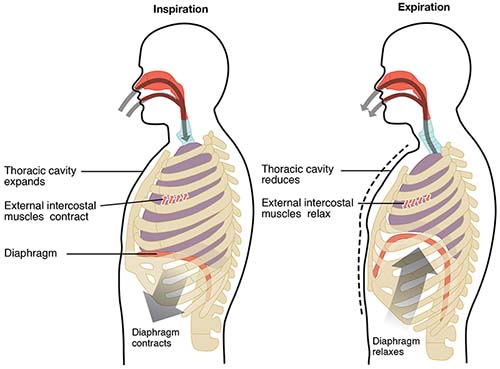What is the difference between breathing and respiration?
BREATHING is the mechanical action of getting air in and out of the lungs.
RESPIRATION is the chemical reaction that provides the energy that makes the organism function. It occurs in the cells, more precisely in the mitochondria (the powerplant of the cell).

RESPIRATION AND BREATHING CONCEPT MAP
BREATHING is carried out by expanding and contracting the ribcage (chest) using the muscles located in between the ribs (these comprise the meat eaten when people have ribs from pork or whatever animal). The diaphragm is another muscle that participates in this process. It is a thin layer of muscle, separating the thoracic cavity from the abdominal cavity. When the diaphragm moves downwards it pulls air into the body as if it was the plunger of a syringe.
Once air, containing the valuable oxygen (about 20%) is inside the lungs, the oxygen is transported, via bloodstream, to the cells all over the body, where respiration takes place.
RESPIRATION is the reaction that converts oxygen and glucose into carbon dioxide, water and releases ENERGY to be used elsewhere!

Diagram of breathing (credit to OpenStax College)
Organisms need energy to move, to keep warm, to perform digestion and other chemical processes, etc.
Respiration is a chemical reaction that transfers chemical energy contained in the glucose molecule to the ATP molecule, which is the energy "currency" of living things.
ATP is consumed by your organism even if you do nothing. The consumption increases when you exercise, when you think, when you feel cold, etc...
Finally, remember that plants also do respiration, although they obviously don't breath as we do.
Insects don't breath either. They don't have lungs. How insects get their oxygen into the body?

